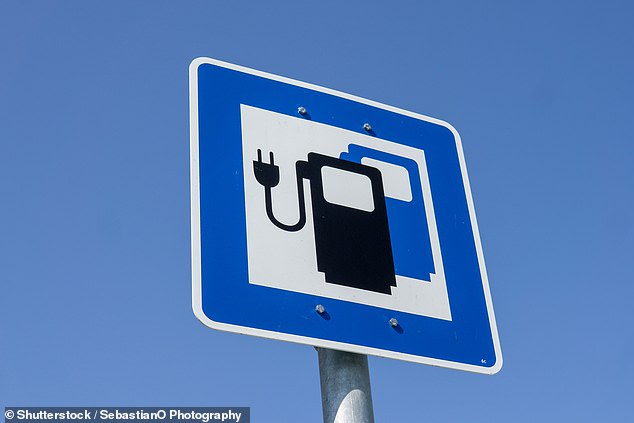A public electric car charger has been added to the nation’s road network every 33 minutes on average over the last 12 months.
There have been 15,979 public chargepoints installed since October 2024, new figures from the Department for Transport show.
Charging infrastructure grew by 23 per cent, which the Government says is ‘enabling people to travel with ease and confidence’.
The official figures show there are now 86,021 chargers on Britain’s roads.
Residential ‘on-street’ chargers now make up almost two fifths of all public devices in an effort to make EV ownership more appealing to those without driveways and access to charging at home.
The data also shows there are 17,356 rapid/ultra-rapid chargers – the fastest currently available and typically installed at motorway services and major public spaces – that can charge an electric car’s battery to 80 per cent in 20 to 40 minutes.
But despite the installations over the last year, the network is growing at a slower rate than in did in 2024, when 19,834 public charging points were installed according to industry website Zapmap.
As a result, it looks likely that ministers are on course to miss their green target of having 300,000 public devices in place by 2030.

New figures released by the Department for Transport show that 15,979 public chargepoints have been added to the UK network since October 2024. One every 33 minutes
In the next five years and two months, another 213,979 EV chargers are required to reach the 300,000 figure promised.
Based on the existing shortfall, this means the Government needs to oversee the addition of around 130 chargers per day on average to reach its end-of-decade target.
That’s more than double the volume being added currently.
Based on figures for the first seven months of the year, installations are tracking at just under 50 new chargers a day.
In 2024, the rate was 54 devices per day, proving that the Government is not just behind target, but is dropping further back due to an infrastructure slowdown.
Where some improvement has been made is localised charging networks around residential areas where homeowners have no off-street parking facilities.
Some 38 per cent of devices added to the network in the last year have been these kerbside installations, which are either dedicated charging points or tap into street lamps and provide charging solutions using existing roadside furniture.
With DfT figures showing that nine in ten current EV owners have off-street parking and can charge via a domestic energy tariff, it’s clear that those without driveways are more reluctant to make the transition to a battery car.
And this is very justified, given the cost of charging via the public network is at least twice as expensive as plugging in at home – and up to 10 times pricier in some instances.
Steve Catlin, managing director at Vauxhall, which has been leading the Electric Streets of Britain Campaign to increase residential charging solutions, said: ‘On-street chargers now make up 38 per cent of all charging devices, the second most common public charger type in the country, a huge boost for drivers without a driveway, and a massive step forward in making the UK’s EV journey accessible for all.’

DfT figures show that 9 in 10 current EV owners have off-street parking and can charge via a domestic energy tariff, in a clear sign that those without driveways are more reluctant to make the transition to a battery car
In a potential further boost for those reliant on public charging, last week the Government confirmed it will consider cutting red tape for EV drivers without a driveway, making it easier to install cross pavement charging solutions.
The forthcoming consultation will consider introducing permitted development (PDR) rights for homeowners without a driveway, meaning they would no longer need to seek planning permission to install chargepoints with discreet cross-pavement charging solutions embedded into the pavement, enabling charging cables to run safely from the home to the vehicle.
Once installed, residents without a driveway would be able to benefit from cheap and convenient home charging allowing them to run their EVs for as little as 2p per mile.
Commenting on the Labour’s £381million rollout of 100,000 more public chargepoints across England, Minister for Decarbonisation Keir Mather said: ‘There’s never been a better time to go electri.
‘Chargepoints are up 23 per cent in a year, and we’re helping drivers save with discounts of up to £3,750 on new electric cars, all part of our Plan for Change.
‘We’re also cutting red tape so renters and those without driveways can access affordable home charging, making it easier and cheaper for everyone to make the switch.’

There are currently over 6,000 (July 2025, Zapmap figures) open-access rapid and ultra-rapid chargers within 1 mile of the Strategic Road Network
Where are EV chargers being installed?
Yorkshire and the Humber, Wales, the West Midlands and East of England has seen the most rapid growth.
Between October 2024 and October 2025, the number of public EV charging devices in England outside of London grew by 23.4 per cent, compared to 21.7 per cent in London.
And there are currently over 6,000 (July 2025, Zapmap figures) open-access rapid and ultra-rapid chargers within 1 mile of the Strategic Road Network (England’s motorways and major A-roads).

